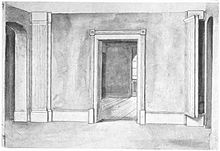Priest hole
A priest hole ( English priest hole ) is a loophole ( hiding ) for priests . These can still be found today in older, formerly Catholic houses in England .
After Henry VIII had established the Church of England and claimed the supremacy for the Crown of England, Catholicism was considered disobedience to the king and was suspected of treason. Roman Catholic priests and religious were persecuted in England from around the beginning of Queen Elizabeth I's reign in 1558. The measures against them were stepped up after revolts and unrest had broken out (e.g. Ridolfi conspiracy 1570/71, Babington conspiracy 1586 etc.). In some cases, fictitious conspiracies (e.g. Papist conspiracy 1678) served as an occasion for restrictive measures against Catholics before (e.g. Exeter conspiracy 1538) and also later .
Arrangement of priestly holes
Priest holes were built or expanded in castles and country houses of Catholic families in England. They were often spartan , but artfully designed hiding places and entrances into which the celebrating priest could slip in an emergency. These hiding places also served as storage space for the sacred vessels and altar furniture.
Many such hiding spots are traced back to the bricklayer , lay brother of the Jesuits and later martyr Nicholas Owen , who is said to have constructed these secret places and access points to protect the lives of the persecuted. In East Riddlesden Hall, such a hiding place was part of the chimney ; in Ripley Castle and Harvington Hall, Worcestershire, part of the wall paneling. At Chesterton Hall (near Cambridge ) the priest hole was part of the toilet .
Owen was captured after the Gunpowder Plot in 1605 at Hindlip Hall, Worcestershire , and tortured to death on the rack in the Tower of London in 1606. He was canonized as a martyr in 1970 (see also: Forty Martyrs of England and Wales ) .
Literary mention
Priest holes are also mentioned in literature and are or were particularly popular subjects in the field of detective novels . For example, B. also Agatha Christie in " Poirot and the Kidnapper " refers to it:
Mention in films
- 2017: Timeless ; Season 1, episode 4: A party at Valar Castle
- 2014: Father Brown ; Episode 11: The Spirits I Called
- 2012: James Bond 007: Skyfall
- 2012: Inspector Barnaby ; Episode 90: You're Dead!
- 2008: Inspector Barnaby: Episode 61: All in red
Web links
- Nicholas Owen's Priest Holes - Last Refuge for Persecuted Priests
- St. Nicholas Owen (Catholic information portal kath-info.de)
- Allan Fea in Project Gutenberg's Secret Chambers and Hiding Places (English)
- Priest hole found in Tudor Hall (English)
- Priest hole in Wolverhampton (English)
- Priest hole Naworth Castle (English with video)
Individual evidence
- ↑ See also: Website of the Jesuits in Austria ( Memento of the original from January 1, 2014 in the Internet Archive ) Info: The archive link was inserted automatically and has not yet been checked. Please check the original and archive link according to the instructions and then remove this notice. (PDF; 78 kB).
- ↑ Allan Fea in Project Gutenberg's Secret Chambers and Hiding Places - Historic, romantic, & legendary Stories & Traditions about Hiding-Holes, secret Chambers, etc. (English).
- ↑ Quoting from Agatha Christie in “ Hercule Poirot asks for the gallows ”, Scherz Verlag , Bern , Munich , Vienna 1983, p. 180, first published in Germany.

